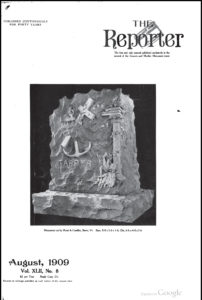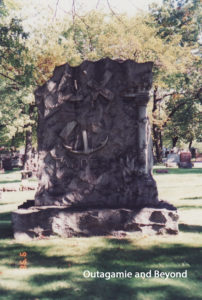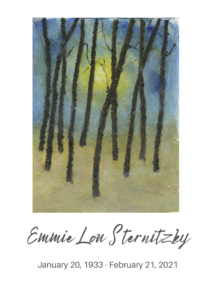A week ago today the weather was miserable in Wisconsin. After two days of 65° degree weather we woke to temps in the 30s, and an expected snowfall of 2-5”. Not the weather we had hoped for as we laid my mother to rest in Neenah’s Oak Hill Cemetery.
We met at the cemetery at 11:00 and headed to what shelter a nearby mausoleum entrance could provide from the snow and sleet. It was a beautiful service with readings and intentions from some of her oldest friends.
Upon leaving the cemetery we headed back to our hotel at the Home2Suites in Appleton. We had two rooms that were adjoining, and so allowed the 12 of us ample seating and room to move around. Mom loved a grazing meal in front of the fire in the library, a glass of wine in hand. We couldn’t provide the fire or library, and we didn’t offer wine, but we had warm coffee, cupcakes, and all the cheeses and charcuterie meats she loved.
As a genealogist, I love to tell stories. As the keeper of the photos, my mother loved to identify, date to the best of her ability, and gather them into an album of sorts for all to view. Last week we played on the room’s massive TV a slideshow I had put together of her life.
In the past, we have done photo boards where pictures are randomly tacked to foam core sheets, and placed along the receiving line. For my mother-in-law, I created a movie using actual footage from their wedding and adding images of her and my father-in-law through the years. I was a bit ahead of my time as it didn’t transfer to a form that would play well at the dinner after the funeral.
This time we had a bit more control as we sent the slideshow from my laptop to the Apple TV.
As people entered the room, the kids had it playing and the coffee brewing (we brought a 12 cup pot from home, along with a favorite flavored decaf). The images stopped people in their tracks. 51 images with captions flowed across the screen. Mom and her brother as young children, mom as a teen in red shoes, a 1947 selfie stating “Me ’47 taken by me,” when she was 14. An image from her days studying at the Art Institute of Chicago, graduation from Drake University in 1955. Her summer trip to Europe where she and two college friends traveled 2900 miles over 31 days in a small Renault, visiting France, Luxembourg, Germany, Austria, Italy, Switzerland, back to France, London, Scotland, back to London then the ship back to New York. Her days working at Quaker Oats in the Merchandise Mart in Chicago, meeting my father, their marriage and move to New York City. The birth of their first child, me, and the second, my brother. Images of us as a family, and her days working as the secretary at First English Lutheran Church in Appleton. Images through her life. A snapshot of time. A life. My mom’s life.
Because of COVID and distance, it took a year for this to happen. But I think she would have been pleased with how the day came together. Rest in peace mom.
It has been many years since I last had the opportunity to stop at Hammond, Lake County, Indiana to visit the graves of my grandparents and great-grandparents. In fact, the last time was in 1999, and on our way home, Mom and I stopped in Tomah, Wisconsin to pick up our new miniature schnauzer puppy, Gretchen. Today in 2017, as we drove home from moving our son to Rhode Island, my husband and I did not have the luxury of time to stop as we drove by the exit, as we had to get home in order to pick up our 4 month old miniature schnauzer puppy, Lizzy, from where she was being boarded during the move.
 My great-grandparents are buried in Oak Hill Cemetery. In 1909 Anton Tapper placed a large, well massive, granite monument in the cemetery, the TAPPER monument. This monument, reported to be the largest monument in Oak Hill Cemetery at the time, weighs 17 tons, stands over 8 feet tall, and sits on a base that is 8 X 5’6.” Cut by the Rossi & Casellini Company of Barre, Vermont, it was delivered and placed by the Ernst Wunderlich Granite Co., of Joliet, Illinois. It was “put in position without damage to a single shrub in the cemetery.” ((“Among the Dealers, Trade Changes and Work Being Done. Joliet, Ill,” The Reporter, August 1909, 9, p378 pdf; digital images, Google, Google Books (books.google.com : accessed 2 Jun 2012).)) Anton was reported to have paid $1,500 for the stone to be cut and placed. ((”The Rounder Says,” The Hammond Times, 12 Aug 1908, Wednesday, p. 2, col. 5-6; digital images, NewspaperARCHIVE (www.newspaperarchive.com : accessed 26 Feb 2016).)) I find it interesting that the stone was described as being “a plain monument,” but even more interesting, was the statement that “in the lot will be placed several concrete receptacles for the bodies which will repose there in the future.” “When the coffin is placed in these receptacles they will be hermetically sealed with concrete several inches thick so that the bodies could only be removed by blasting away at the concrete.” ((Ibid.)) I wonder what his reasoning was for this? Grave robbers?
My great-grandparents are buried in Oak Hill Cemetery. In 1909 Anton Tapper placed a large, well massive, granite monument in the cemetery, the TAPPER monument. This monument, reported to be the largest monument in Oak Hill Cemetery at the time, weighs 17 tons, stands over 8 feet tall, and sits on a base that is 8 X 5’6.” Cut by the Rossi & Casellini Company of Barre, Vermont, it was delivered and placed by the Ernst Wunderlich Granite Co., of Joliet, Illinois. It was “put in position without damage to a single shrub in the cemetery.” ((“Among the Dealers, Trade Changes and Work Being Done. Joliet, Ill,” The Reporter, August 1909, 9, p378 pdf; digital images, Google, Google Books (books.google.com : accessed 2 Jun 2012).)) Anton was reported to have paid $1,500 for the stone to be cut and placed. ((”The Rounder Says,” The Hammond Times, 12 Aug 1908, Wednesday, p. 2, col. 5-6; digital images, NewspaperARCHIVE (www.newspaperarchive.com : accessed 26 Feb 2016).)) I find it interesting that the stone was described as being “a plain monument,” but even more interesting, was the statement that “in the lot will be placed several concrete receptacles for the bodies which will repose there in the future.” “When the coffin is placed in these receptacles they will be hermetically sealed with concrete several inches thick so that the bodies could only be removed by blasting away at the concrete.” ((Ibid.)) I wonder what his reasoning was for this? Grave robbers?
According to records at the cemetery, Anton purchased 14 grave sites, with the monument covering three of them. I am not sure when he purchased the plot, but the cemetery records show that six graves have been filled: Gretje Tapper, his mother; Lois Tapper, his daughter who was born pre-mature at 6 months, and living just one day; his wife, Louise Tapper; his grandson, stillborn child of his daughter Alice; and himself. There is one remaining grave that is occupied, but not noted as to who is buried there. Two people come to mind as to who it might be, and obviously further research needs to be done. It could be his step-father, Edzard Heinrich Tapper, who died 22 Dec 1881, or it could be his brother, Folkert Tapper who passed away 18 May 1888. The cemetery was established in 1885, so Folkert would be a likely candidate. So we circle back to the question of when the plot was purchased, and by whom. It is likely that a couple of lots were purchased by Gretje when Folkert died, but at this point it is only speculation.
When Anton designed the monument, he chose very specific images. There has been much written about the symbolism of carvings on a tombstone, gravestone or monument. While I am sure that many choose what symbols to decorate these eternal stones from the standard catalogue and meaning, I believe that these symbols can also have a different, or secondary meaning.
- Included on the stone are these images:
An Anchor, traditionally a symbol of hope, or eternal life. I love the idea that early christians used it as a disguised cross.
- A Cross, traditionally a symbol of faith and eternity.
Alternately: A Cross and Anchor, which refers to Christ as “hope we have as an anchor of the soul, both sincere and steadfast.” (Hebrews 6:19). ((http://www.memorials.com/Headstones-Symbolism-information.php : accessed 19 Mar 2017.))
- A Column traditionally symbolizes the noble life of the head of the family.
- Ivy, traditionally a symbol of eternal life.
- Ferns, traditionally a symbol of humility and sincerity.
- A Lily traditionally symbolizes purity or resurrection. In this case the flower is below the leaves, it could represent a broken flower, meaning pre-mature death.
Putting myself in my great-grandfather’s shoes, I believe that he took all of this into consideration, but also looked at it from a slightly different angle.
- The Anchor and Cross. Anton was the son of a sea captain, his father having died at sea when he was just two years old. He lost his brother when he was six, and his younger brother died either on the voyage to America, or shortly after landing. I wrote about this in my blog post titled “Strength at Christmas.” His only remaining brother, Folkert, died at the age of 21 in 1888. The anchor and cross, symbols of hope, faith, eternal life, and a symbol of his father, the captain of the Three Sisters.
- The Column. The noble life of the head of the family – his mother. A strong and determined woman, who did all she could to create a good life for her family.
- Ivy and Ferns. Again hope for eternal life, with humility and sincerity.
- A broken lily. Pre-mature death. He certainly experienced enough pre-mature death.
The reason for his choices have been lost in time, but the monument stands, tall and solid. A testament to the strength and endurance of this pioneer family of Hammond, Indiana.


SaveSave



